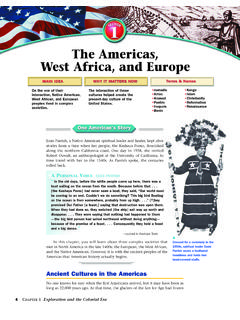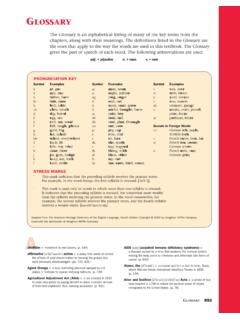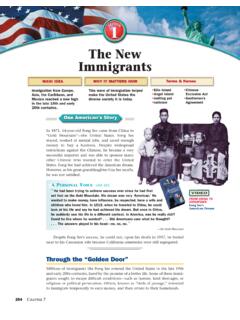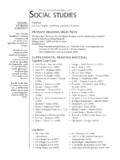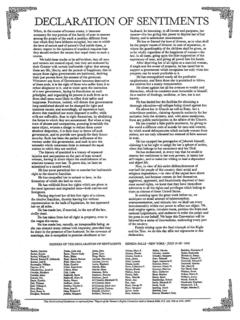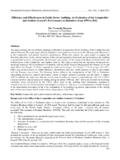Transcription of Confederation and the Constitution
1 66 CHAPTER2 Revolution and the Early RepublicTerms & NamesTerms & NamesMAIN IDEAMAIN IDEAOne American's StoryConfederation andthe Constitution republic Articles ofConfederation NorthwestOrdinance of 1787 Shays s Rebellion James Madison federalism checks andbalances ratification Federalists Antifederalists Bill of RightsAmerican leaders createdthe Constitution as a blue-print of government for theUnited States. More than 200 years after itscreation, the Constitutionremains the nation s guidingdocument for a workinggovernment. WHY IT MATTERS NOWWHY IT MATTERS NOWJohn Dickinson understood, perhaps better than other dele-gates to the Continental Congress, the value of compromise.
2 In1776 Dickinson hoped for reconciliation with Britain andrefused to sign the Declaration of Independence. Yet, eightdays after the Declaration was adopted, Dickinson presentedCongress with the first draft of a plan for setting up a workablegovernment for the new states. A PERSONALVOICEJOHN DICKINSON Two rules I have laid down for myself throughout this contest .. first, on all occasions where I am called upon, as atrustee for my countrymen, to deliberate on questions impor-tant to their happiness, disdaining all personal advantages tobe derived from a suppression of my real sentiments .. open-ly to avow [declare] them; and, secondly, .. whenever thepublic resolutions are taken, to regard them though oppositeto my opinion, as sacred.
3 And to join in supporting them asearnestly as if my voice had been given for them. quoted in The Life and Times of John Dickinson, 1732 1808 Dickinson s two rules became guiding principles for theleaders who faced the formidable task of forming a new nation. Experimenting with ConfederationAs citizens of a new and independent nation, Americans had to create their ownpolitical system. Fighting the Revolutionary War gave the states a common goal,but they remained reluctant to unite under a strong central DickinsonBAfter the Revolution, many Americans favored a republic a government inwhich citizens rule through their elected representatives. However, many alsofeared that a democracy government directly by the people placed power in thehands of the uneducated masses.
4 These fears and concerns deeply affected the plan-ning of the new ARTICLES OF CONFEDERATIONThe Second Continental Congress set upa new plan of government in a set of laws called the Articles of plan established a form of government called a Confederation , or alliance,among the thirteen Articles set up a Congress in which each statewould have one vote regardless of population. Powers weredivided between the states and the national national government had the power to declare war,make peace, and sign treaties. It could borrow money, setstandards for coins and for weights and measures, andestablish a postal service.
5 After approval by all thirteenstates, the Articles of Confederation went into effect inMarch of the first issues the Confederation faced had todo with the the Northwest Territory, lands west of theAppalachians, where many people settled after theRevolutionary War. To help govern these lands, Congresspassed the Land Ordinance of 1785, which established aplan for surveying the land. (See Geography Spotlight onpage 72.) In the Northwest Ordinance of 1787,Congress provided a procedure for dividing the land into nofewer than three and no more than five states. The ordi-nance also set requirements for the admission of new states,which, however, overlooked Native American land Land Ordinance of 1785 and the Northwest Ordinance of 1787 becamethe Confederation s most significant achievements.
6 Overshadowing such success-es, however, were the Confederation s many problems. The most serious problemwas that each state functioned independently by pursuing its own interests ratherthan considering those of the nation as a whole. The government had no meansof raising money or enforcing its laws. Moreover, there was no national court sys-tem to settle legal disputes. The Articles of Confederation created a weak centralgovernment and little unity among the S REBELLIONThe need for a stronger central government becameobvious in 1786 when many farmers in western Massachusetts rose up in protestover increased state taxes. The farmers discontent boiled over into mob action inJanuary of 1787 when Daniel Shays, a fellow farmer, led an army of 1,200 farm-ers toward the arsenal at Springfield, Massachusetts.
7 State officials hurriedly calledout the militia to head off the army of farmers, killing four of the rebels and scat-tering the s Rebellion,as the farmers protest came to be called, caused panicand dismay throughout the nation. It was clearly time to talk about a strongernational government. Because the states had placed such severe limits on the gov-ernment to prevent abuse of power, the government was unable to solve many ofthe nation s problems. News of the rebellion spread throughout the states. Therevolt persuaded twelve states to send delegates to a convention called byCongress in Philadelphia in May of of the Articles of Confederation Congress could not enact andcollect taxes.
8 Each state had only one vote inCongress, regardless of population. Nine out of thirteen states neededto agree to pass important laws. Articles could be amended only if all states approved. There was no executive branch toenforce laws of Congress. There was no national court system to settle legal disputes. There were thirteen separatestates that lacked national IDEAMAIN IDEAAC ontrastingWhat was the differencebetween the Land Ordinance of 1785 and the NorthwestOrdinanceof 1787?MAIN IDEAMAIN IDEABM akingInferencesWhy do youthink news ofShays s Rebellionmade states eagerto participate in the Philadelphiaconvention?Creating a New GovernmentMost of the delegates at the Constitutional Convention recognized the need tostrengthen the central government.
9 Within the first five days of the meeting, theygave up the idea of fixing the Articles of Confederation and decided to form anentirely new government that would replace the one created by the AND COMPROMISEOne major issue that the delegates faced wasgiving fair representation to both large and small states. James Madisonpro-posed the Virginia Plan, which called for a bicameral, or two-house, legislature,with membership based on each state s population. Delegates from the smallstates vigorously objected to the Virginia Plan because it gave more power tostates with large populations. Small states supported William Paterson s NewJersey Plan, which proposed a single-house congress in which each state had anequal debate became deadlocked and dragged on through the hot and humidsummer days.
10 Eventually, Roger Sherman suggested the Great Compromise,which offered a two-house Congress to satisfy both small and big states. Eachstate would have equal representation in the Senate, or upper house. The size ofthe population of each state would determine its represen-tation in the House of Representatives, or lower of each state would choose members of the state legislatures would choose members of the Great Compromise settled one major issue but ledto conflict over another. Southern delegates, whose stateshad large numbers of slaves, wanted slaves included in thepopulation count that determined the number of repre-sentatives in the House.

